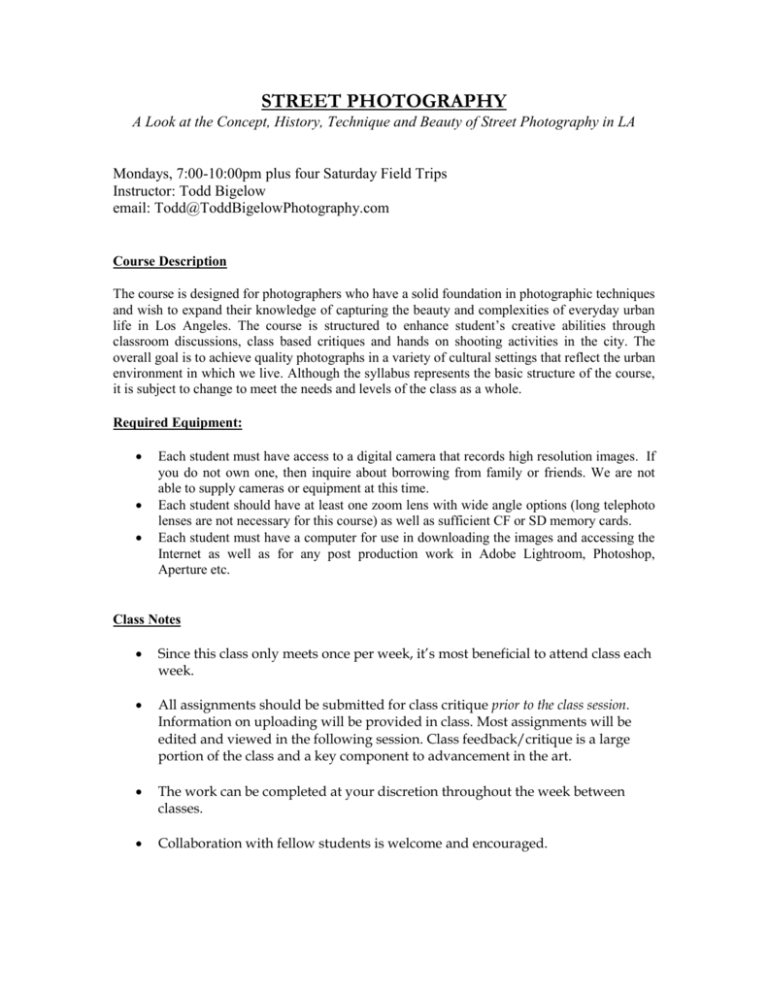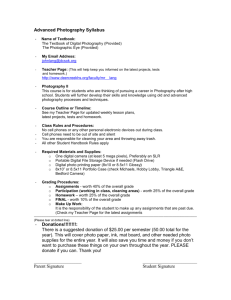PHOTOJOURNALISM (J350) - UCLA Extension Visual Arts
advertisement

STREET PHOTOGRAPHY A Look at the Concept, History, Technique and Beauty of Street Photography in LA Mondays, 7:00-10:00pm plus four Saturday Field Trips Instructor: Todd Bigelow email: Todd@ToddBigelowPhotography.com Course Description The course is designed for photographers who have a solid foundation in photographic techniques and wish to expand their knowledge of capturing the beauty and complexities of everyday urban life in Los Angeles. The course is structured to enhance student’s creative abilities through classroom discussions, class based critiques and hands on shooting activities in the city. The overall goal is to achieve quality photographs in a variety of cultural settings that reflect the urban environment in which we live. Although the syllabus represents the basic structure of the course, it is subject to change to meet the needs and levels of the class as a whole. Required Equipment: Each student must have access to a digital camera that records high resolution images. If you do not own one, then inquire about borrowing from family or friends. We are not able to supply cameras or equipment at this time. Each student should have at least one zoom lens with wide angle options (long telephoto lenses are not necessary for this course) as well as sufficient CF or SD memory cards. Each student must have a computer for use in downloading the images and accessing the Internet as well as for any post production work in Adobe Lightroom, Photoshop, Aperture etc. Class Notes Since this class only meets once per week, it’s most beneficial to attend class each week. All assignments should be submitted for class critique prior to the class session. Information on uploading will be provided in class. Most assignments will be edited and viewed in the following session. Class feedback/critique is a large portion of the class and a key component to advancement in the art. The work can be completed at your discretion throughout the week between classes. Collaboration with fellow students is welcome and encouraged. COURSE OUTLINE: STREET PHOTOGRAPHY Please remember that your images need to be uploaded well PRIOR to class so that we can all enjoy and create a dialogue amongst ourselves about the work. Session 1: Please bring cameras to class. Introduction to the course syllabus and requirements. Setting up your camera to maximize quality: o Exposures: Auto vs Manual, Aperture Priority vs Shutter Priority: What does it all mean? o Jpgs, Raws, White Balance. Setting up your camera to record the images. o Why your gear and approach is critical to street photography. Discussion: o What is Street Photography? What is photojournalism?A Introduction o The Composition as a Key Component in a great image. o Presentation: The Power of Composition in Street Photography Assignment #1: Compostion o The KEY aspect to this assignment is an interesting composition. Make sure these are “captured moments” and not set-up. o Spend time in any urban setting with people and create interesting, layered compositions as discussed in class. Session 2 Discussion: o Moments: The Beauty of Capturing Everyday Moments in Urban life. o Finding images where you think there are no opportunities. o Seeing potential in the setting. o Patience: The necessity for letting the scene unfold naturally. o Presentation: Moments Henri Cartier Bresson: The impact and understanding of his theory “The Decisive Moment” and a look at his renowned work. Assignment #2: Moment o The KEY aspect to this assignment is the moment. As illustrated in class, sometimes these moments are obvious (a man jumping a puddle), sometimes they are very subtle (a furtive glance), but it’s essential to time your image to capture more than just a scene, but a moment within the scene. Class review of student work from Assignment #1 Session 3 Discussion: o What sort of barriers do street photographers face and how to overcome them. o Discussing the challenges you have already faced while photographing. o Presentation: Garry Winongrand, considered by many to be the greatest ever urban, street photographer. A discussion of his approach and legendary archive of urban photography. Class Review of Student Work from Assignment #2. Assignment #3 o Shoot With Interesting Light. Do not ignore composition or moment, but key on light. Session 4: Discussion: o The importance of understanding culture. o Using your understanding to find interesting settings to shoot. o Presentation: Robert Frank A discussion of his use of narrative in his approach to urban photography. Review of the famous photographer’s work, especially The Americans. Class Review of Student Work from Assignment #3. Session 5: Assignment #4: Saturday Field Trip to Beverly Hills, Rodeo Drive area. 2-5pm Shooting in the wealthy enclave to capture images of this famous part of LA. Session 6: Discussion: o Street photography and its relationship to travel photography. o Urban photography is represented best through the people. o Presentation: Mary Ellen Mark: A discussion of her style of urban photography. o Class Review of Student Work from Assignment #4. Session 7: Assignment #5: Saturday Field Trip Hollywood. 2-5pm o Shooting in the iconic town while avoiding the obvious tourist photos. Session 8: Discussion: o o o o Capturing the essence of a city through true, random encounters. Anticipating the randomness! Using a preplanned idea to capture the pulse of a city. Presentation: Douglas McCullough: A discussion of Chance Encounters, his book chronicling Los Angeles with his interpretation of street photography. Class Review of Student Work from Assignment #5 Session 9: Assignment #6: Saturday Field Trip to Downtown Los Angeles and vicinity. 2-5pm Session 10: Discussion: o Elliott Erwitt o “It's about reacting to what you see, hopefully without preconception. You can find pictures anywhere. It's simply a matter of noticing things and organizing them. You just have to care about what's around you and have a concern with humanity and the human comedy. ”- Elliott Erwitt. o Why urban settings are great for visuals. Class Review of Student Work from Assignment #6 Session 11: Assignment #7: Saturday Field Trip Field Trip to Venice Beach, drawing on inspiration from Erwitt and others, to capture the essence of the unique and historical environment. Session 12: Discussion: o Vivian Maier: A look at this most unbelievable story of the woman who worked as a Nanny in Chicago while, without the support or knowledge those around her, compiled some of the greatest urban street photography in history. Class Review of Student Work from Assignment #7 Overall Class Review and Discussion on how to progress. PLAGIARISM: Plagiarism will not be tolerated, and anyone caught misrepresenting another artist’s work as their own will be removed from the class. Please respect the intellectual property of other artists. Please also remember that much of the information posted on the Internet is protected by U.S. copyright laws. Passing this information off as your own is a violation of federal law. GRADING: Grading will be calculated by accumulation of points derived from six assignments. Assignments 1-6 are worth 10 Points. Assignment 7 is worth 20 points. Class Participation is worth 20 points. 90-100 points A 80-89 points B 70-79 points C 60-69 points D 50-59 points F Assignment Requirements: All images must be uploaded by designated time OR provided on a flash drive at the instructors request as outlined each semester in class. Late assignments not accepted. All images must be provided in high resolution jpeg format (at least longest dimension at 12 inches/300dpi) All images must be original and taken during completion of course assignment. All images evaluated with consideration to the specific assignment as detailed in class. All images are NOT to be manipulated beyond basic, acceptable standards of color, contrast, brightness adjustments. Digital manipulation of images including, but not restricted to, adding or removing objects, dramatic aesthetic adjustments or use of manipulative filters is NOT acceptable and will result in a failing grade. Class participation is taken into consideration as part of the overall grade. Class attendance is taken into consideration as part of the overall grade. Since the class meets only 12 times, 4 or more absences will result in a automatic failing grade. Respectful, open minded critiques of work is to be expected.








